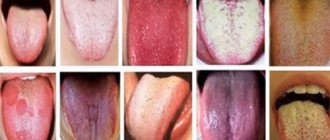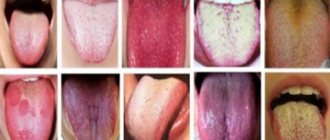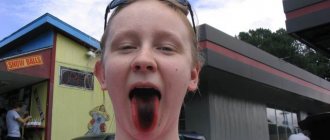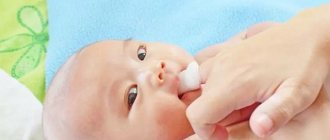If on child's language bubbles appear, do not try to get rid of them yourself. Surely there were reasons for their occurrence, and only a specialist can accurately determine them. First, the doctor must find out what exactly triggered the formation of painful blisters on the child’s tongue. The reasons vary. Most often, white blisters appear due to a fungal infection or thrush. Also, their occurrence could be detected by severe dysbacteriosis or as an allergy. It should be noted that most allergic reactions manifest themselves in the form of urticaria, diathesis or dermatitis.
Causes of bubbles on a child’s tongue
In order to help the child as quickly as possible and prescribe appropriate treatment, it is necessary to determine the causes of the formation of bubbles on the child’s tongue. The very first reason why the mucous surface of a child’s tongue becomes covered with pimples is thrush. Often, this disease affects young children whose immunity is severely weakened. Small white bubbles form not only on the surface of the tongue, but throughout the entire oral cavity.
Treatment consists of frequent wiping of the mouth with a tetraborate solution, which contains glycerin. Sometimes doctors prescribe glycerin-based borax. All these drugs are easily available and are available even without a doctor's prescription. Therapy is carried out as follows. Take a piece of clean bandage and wrap it around your index finger, then moisten it generously in the liquid and gently wipe your tongue, and then your entire mouth. Try not to press on the tongue as this may trigger the baby's gag reflex. A similar treatment of the oral cavity should be carried out after each meal.
Causes of pimples in the mouth
70% of red, white or pinkish rashes in the oral cavity, including on the tongue, indicate the presence of a serious dental disease. The asymptomatic course of the disease does not mean that the “trouble” will go away on its own. However, prescribing treatment on your own, guided by the advice of friends or recommendations from the Internet, is dangerous.
Important!
In principle, there cannot be acne on the tongue. Purulent skin rashes develop due to inflammation of the sebaceous glands, which are not present in the mouth. Accordingly, we call those pimples that appear in the oral cavity “pimples” by analogy. Just by external similarity.
There are several reasons for the appearance of irritations that visually resemble pimples:
- mechanical damage. A prick with a fish bone, a scratch, a burn from hot coffee can provoke a similar pathology;
- allergy. Not necessarily to foods; a seasonal allergic reaction is possible, manifesting itself in such an unusual way;
- viral and infectious diseases. Herpes, rubella, scarlet fever and ARVI sometimes manifest themselves as rashes in the mouth;
- fungal infection (candidiasis);
- stomatitis. Usually, with stomatitis, pimples first appear on the gums, but sometimes red spots with a whitish halo, which react sharply to touch or spicy/hot food, form over the entire lingual surface.
There is no point in waiting until diseases become chronic. In 98% of cases, such pathologies are treated quickly and inexpensively, if you do not neglect the condition and do not self-medicate.
Another reason for the formation of pimples on a baby’s tongue is dysbacteriosis.
With dysbacteriosis, pimples cover the mucous membrane of the child’s tongue and externally resemble small ulcers. Treatment should be started immediately, since such bubbles cause severe pain.
In cases where pimples turn into ulcers, you should pay attention to the condition of the child’s intestines. After all, it is possible that exactly the same ulcers appear there as on the surface of the tongue. Therefore, if you notice even small pimples on a child’s tongue, you should undergo an examination of the whole body. This will allow us to determine the causes of this phenomenon and begin appropriate treatment.
special instructions
In order to exclude the addition of a secondary infection and prevent diseases from penetrating deeper into the larynx, it is prohibited:
- treat yourself without consulting a doctor;
- scratch the growths, touch them with your fingers;
- brush your teeth more than 2 times a day;
- talk a lot (with active articulation there is a danger of opening tumors on the tongue of both the child and the adult, which will lead to the development of ulcers);
- smoke, drink alcohol;
- eat citrus fruits, salty foods, hot seasonings.
Close contacts are also not recommended (to avoid infecting loved ones).
To cure blisters on a child's tongue
In order to eliminate bubbles on a child’s tongue that have formed due to dysbiosis, it is first necessary to undergo treatment aimed at restoring full intestinal functions. If this is a small child, then first you need to deal with nutrition. For example, you can add white cabbage to the cutlets, previously minced through a meat grinder. Cabbage plays the role of a “broom” and removes all harmful elements from the children’s intestines.
If we are talking about the digestion process of infants, then the mother should reconsider her diet. Treatment of blisters can be carried out only after consultation with a doctor. The specialist will select the drug that will not harm the baby.
How to carry out treatment
In order to determine the treatment strategy for blisters, it is necessary to determine their location on the tongue. If there are blisters on the surface of which there is plaque, it is necessary to use oxolinic ointment.
Before carrying out therapy, you must contact a dentist, who will correctly diagnose and select the necessary medications.
Initially, treatment for blisters is carried out with the use of antihistamines. Their production can be carried out in the form of tablets.
The required dose of the tablet must be ground into powder and given to the child. It is allowed to drink it only with clean water. After this, the use of Holisap is recommended. This spray ensures the fastest healing of blisters.
If the disease occurs against the background of a viral infection, then children are given drugs whose action is aimed at suppressing them. If a child has chickenpox, then nothing needs to be done.
A small patient needs constant disinfection of the oral cavity, which will eliminate the possibility of bacterial growth. For this purpose, aloe juice is used, which must first be diluted with water.
It is given to the child in small quantities.
This set of actions must be performed, regardless of the causes of the pathology. The only distinguishing aspect is the use of certain drugs.
Treatment according to location
The selection of a specific treatment method should be carried out depending on the location. If neoplasms appear on the tongue, this indicates the development of:
- Chickenpox;
- Pharyngitis;
- Scarlet fever.
During the course of these diseases, in most cases the body temperature rises. If a child has candidiasis, then the blisters are also on the tongue.
They are characterized by the presence of a white coating on the surface, which can be removed. With stomatitis, plaque cannot be removed. When you try to eliminate it, bleeding will occur.
Blisters should be treated according to the cause of their appearance. That is why it must be prescribed by a specialist.
Traditional and folk medicines
Treatment of blisters on the tongue in children can be carried out using traditional medicines or traditional medicine. Among pharmaceutical drugs, sprays and gels are quite effective.
With their help, the pathogenic environment is removed. To ensure the most effective healing of blisters, the use of Holisap and Chlorophyllipt is recommended.
In parallel, the child is prescribed other drugs, the action of which is aimed at eliminating the cause of the appearance of this symptom. To eliminate rashes, special patches can be used that have an anti-burn effect.
Treatment with these drugs is permitted only if the child is over five years old. To eliminate the manifestations, it is recommended to use oxolinic ointment, which is the most effective and safe.
In order to eliminate fungal infections, children are prescribed Nystatin ointment.
Traditional medicine has a high effect in the treatment of blisters. In most cases, therapy is carried out using decoctions of beneficial herbs.
To prepare the medicine, you need to take chamomile flowers and the ground part of sage and mix in equal quantities, add water and boil for 10 minutes. After this, the decoction must be left for an hour.
Blisters can be caused by stomatitis, this is discussed in this video:
It is recommended that the child take it orally. If the baby is 4 years old, then he should be given no more than two tablespoons of medicine per day. Every year the dosage of the folk remedy increases by half a tablespoon.
Therapy for blisters on the tongue in children can also be carried out using aloe or Kalanchoe. With the help of the first flower, the fastest healing of wounds that form at the site of the vesicles is ensured.
One leaf of the old plant must be washed and skinned. Next, the juice is squeezed out of the flower and mixed with water. It is recommended to rinse the mouth with the help of the medicine.
This medication is also approved for oral administration.
The daily dose of the medicine should be no more than one tablespoon. Before swallowing the folk remedy, the child should be advised to hold it in his mouth. The longer he does this, the better.
If there is no aloe flower in the house, it can be replaced with Kalanchoe. During the treatment of pathology with traditional medicines, in order to avoid undesirable effects, it is recommended to take into account contraindications.
Despite the fact that traditional medicine is safe, before using any of them, you should consult a doctor.
Quite often, children develop pimples on their tongues caused by an allergic reaction of the body.
If there is an allergy, the child's tongue becomes covered exclusively with white blisters. This is their main feature. First, you need to exclude foods that could cause allergies from your diet. You will also temporarily have to give up scented soaps, powders and other detergents of synthetic origin. Believe me, regular baby soap or laundry soap will be much more beneficial in this case. Try to wet clean your home and remove dust more often. It is recommended to treat blisters on the tongue of infants with a regular soda solution.
Dear mothers, do not forget that only a qualified specialist can accurately determine the cause of bubbles on the child’s tongue and prescribe the necessary course of treatment.
Do not self-medicate at home, because the most valuable thing is at stake, namely the health of your baby! The main reasons for the formation of bubbles on a child’s tongue
First aid
Blisters on the tongue cannot be ignored. If a rash is detected, you must contact a medical facility for examination and consultation with a doctor.
If it is not possible to visit a therapist, then to alleviate the patient’s condition, it is recommended to take the following measures:
- Rinse . The use of antiseptics Miramistin and Chlorhexidine is allowed. It is possible to disinfect neoplasms that appear on the root of the muscular organ with Furacilin solution. It is also recommended to rinse your mouth with decoctions of medicinal herbs (calendula, chamomile). The frequency of procedures is at least 3-4 times a day. A blister on the tongue (both on the body of the muscular organ and near the throat) is treated with concentrated solutions of soda or a mixture of soda and salt.
- Use of an antifungal drug . Blisters found on the tongue during candidal stomatitis are advised to be treated by using the medication Nystatin.
- Use of painkillers .
Dentists recommend regularly cleaning the surface of the oral cavity from accumulated plaque using a special tool (scraper). At the end of the manipulation, it is necessary to thoroughly massage the body of the tongue with a soft-bristled toothbrush.
Additional ways to reduce pain and irritation of the mucous membranes in the presence of small white blisters are complete abandonment of bad habits and a strict diet.
Traditional medicine recommends treating red blisters with infusions of sage and oak bark.
After removing the acute symptoms of the disease and alleviating the general condition of the patient, you should contact a medical clinic specialist who will advise the necessary treatment regimen, taking into account the severity of the disease and the frequency of exacerbations.
Factors contributing to the formation of bubbles:
- Oral diseases: caries, pulpitis, periodontitis, stomatitis;
- Unbalanced diet;
- Allergy to toothpaste or mouthwash;
- Injuries;
- Poor hygiene;
- Hereditary predisposition;
- Hormonal imbalance;
- Immunity impairment;
- Alcohol and nicotine addiction.
Watery blisters on the mucous membrane in some cases can indicate the occurrence of serious diseases. Such manifestations occur with tuberculosis, syphilis or diabetes. Therefore, if such a pathology occurs, it is recommended to immediately make an appointment with a doctor and undergo the necessary examination. The first sign is the sensation of a strange object in the mouth that is in the way.
Treatment methods depending on the cause:
- If the formation occurs due to a viral infection, then treatment will be based on the use of antiviral drugs;
- If the cause is injury, then it is necessary to eliminate the consequences and rinse the mouth with antiseptics;
- If an allergic reaction provokes an illness, then you should find out what the irritant is and not use it anymore. The doctor will also prescribe antihistamines;
- If a large bloody bubble has formed, then surgery is performed. After this, the doctor prescribes medications for rapid tissue regeneration and restoration.
Analogs and substitutes for "Chlorhexidine"
This liquid is the cheapest and most versatile antiseptic. There are more expensive analogues:
- "Miramistin";
- "Malavit";
- "Hexicon";
- "Protargol";
- "Betadine";
- "Rotokan".
“Betadine” (10% solution) is also successfully used for stomatitis in children and in surgery, dentistry, combustiology, transplantology, ophthalmology, and traumatology. It is an excellent prevention of further spread of infection from the oral cavity to the internal organs. Can be used not only in a hospital setting, but also for treatment at home.
Benign tumors of the tongue
The clinical course of a tongue tumor and the characteristics of its growth are associated mainly with the type of tissue from which it originates. The presence of epithelial, muscle, glandular, and adipose tissue in the tongue structure, as well as the possible entry into the tongue tissue during embryogenesis of the rudiments of other tissue structures (bone, cartilage, thyroid tissue) determine a wide variety of clinical forms of tongue tumors. Most often dentistry encounters vascular tumors of the tongue (angiomas). The second place in prevalence is occupied by papillomas, the third place by fibroids of the tongue.
Papilloma . This tumor of the tongue grows from the stratified squamous epithelium of its mucosa. Most often it occurs on the back and tip of the tongue. Papillomas are multiple or single formations of pale pink color, round or elongated, rarely growing to large sizes. The appearance of keratosis on the surface of the papilloma, as a rule, indicates its malignant degeneration. In some cases, spontaneous involution of papilloma was observed.
Adenoma . Formed from the glands of the tongue mucosa. Cystoadenomas are more often observed on the tip of the tongue. In the area of the root of the tongue, polyps from the heterotopic gastric mucosa may appear.
Botriomyxoma . The tongue tumor is flat or spherical in shape, in rare cases divided into several lobules. Initially it is red in color, but over time it becomes brown. In its growth it can reach the size of a walnut. The surface of botryomyxoma can be smooth or coarse-grained, often covered with crusts. Factors that provoke the formation of this type of tongue tumor include trauma and tongue fissure.
Fibroma . A round tumor of the tongue of elastic consistency, growing from connective tissue cells. Fibroids can grow on a stalk. Its color often does not differ from the color of the mucous membrane, in other cases it has a yellowish or whitish tint.
Retention cyst . Most often located on the lower surface of the tongue in the area of its tip. It has a multiple character. This tumor of the tongue develops from the nunnia glands located in its superficial muscle layer.
Lipoma . A tumor of the tongue developing in the submucosal layer with a lobular structure and a soft-elastic consistency. It is most common on the undersurface at the back of the tongue. Lipoma is characterized by slow growth and painless course.
Myoma . A tumor of the tongue that occurs when the cells of its muscles proliferate. It often has a size of up to 1 cm and a dense consistency, but can grow to a significant size. Covered with mucous membrane. It is usually localized on the upper surface of the tongue. In some cases, small papillary outgrowths are observed on the surface of the fibroid.
Neurofibroma . They develop from the tissues of the nerve branches passing through the tongue, most often in the posterior half of the tongue. This type of tongue tumor occurs in rare cases and is characterized by slow growth. May be accompanied by various pain sensations.
Hemangioma . Tumor of the tongue, originating from the tissues of blood vessels. Associated with a violation of embryogenesis, more often observed in girls. This tongue tumor is usually detected at birth or in early childhood. Capillary hemangioma appears as red spots of various sizes and shapes that do not rise above the surface of the tongue. The spot turns pale when pressed. Cavernous hemangioma is a tumor of the tongue with a bluish-purple color and soft consistency. Often rises above the surrounding mucosa. Characterized by deep germination into the underlying tissues. Pressure on the tumor leads to a decrease in its size, which quickly recovers when the pressure is removed. Vascular tumors of the tongue may be accompanied by bleeding, most often caused by injury.
Lymphangioma
. It grows from the walls of the lymphatic vessels of the tongue and appears in the first years of a child’s life. It can cause diffuse damage to the tongue, leading to its significant enlargement. Local lesions are represented by growths of a warty structure with vesicular elements and are most often located along the upper surface of the root or tip of the tongue. When injured by food or teeth, this swelling of the tongue often becomes inflamed.
Struma of the tongue . A rare tumor of the tongue that arises from cells of thyroid tissue that enter the tongue as a result of impaired embryonic differentiation. It is a node localized at the root of the tongue with a diameter of up to 3 cm.
Stomatitis in a child
This is an oral disease caused by various pathogenic and opportunistic microorganisms. It most often occurs in children aged five to ten years. Depending on the stage of the disease, there will be different manifestations:
- at the initial stage, pink pimples on the tongue do not cause the child any discomfort; you can easily get rid of them by rinsing your mouth with medicinal decoctions for several days;
- at the second stage, small red blisters spread along the gums and along the inner surface of the cheek mucosa;
- If stomatitis develops to the last stage and crusts form, you should take a course of antibacterial drugs.
Stomatitis is diagnosed in many children. This disease should not be considered a cause for panic and a threat to the child’s health. Most often, it is enough to rinse your mouth three or four times with Chlorhexidine or Miramistin for several days. After this, the manifestations of stomatitis go away.










